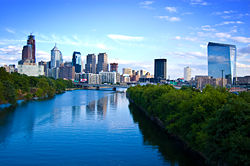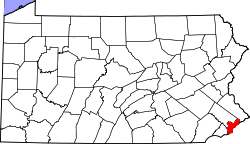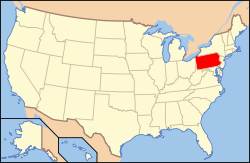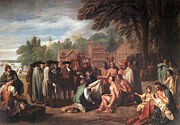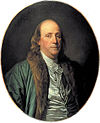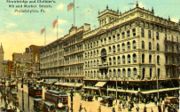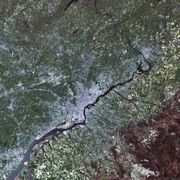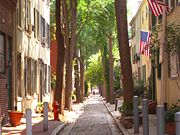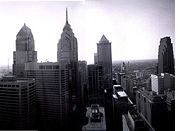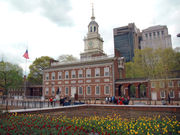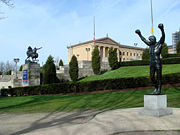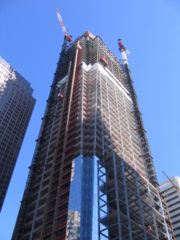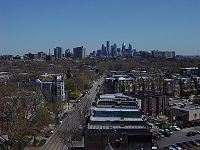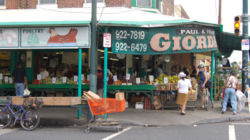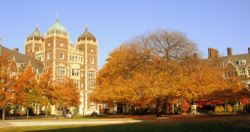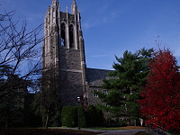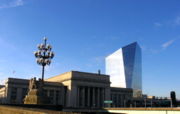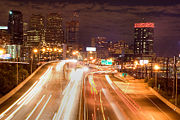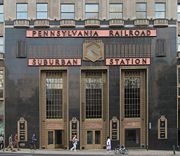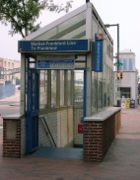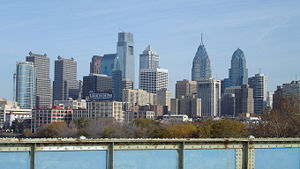Philadelphia
2008/9 Schools Wikipedia Selection. Related subjects: Cities; North America
| Philadelphia | |||
| — City — | |||
| The City of Philadelphia | |||
| Philadelphia skyline, August 2007 | |||
|
|||
| Nickname(s): "City of Brotherly Love","The City that Loves you Back", "Cradle of Liberty", "The Quaker City", "The Birthplace of America", "Philly" | |||
| Motto: "Philadelphia maneto" - "Let brotherly love endure" | |||
| Location in Pennsylvania | |||
| Coordinates: | |||
|---|---|---|---|
| Country | |||
| Commonwealth | |||
| County | |||
| Founded | October 27, 1682 | ||
| Incorporated | October 25, 1701 | ||
| Government | |||
| - Mayor | Michael Nutter ( D) | ||
| Area | |||
| - City | 135 sq mi (349.6 km²) | ||
| - Land | 127.4 sq mi (326.144 km²) | ||
| - Water | 7.6 sq mi (19.6 km²) | ||
| - Urban | 1,799.5 sq mi (4,660.7 km²) | ||
| - Metro | 4,629 sq mi (11,989 km²) | ||
| Elevation | 39 ft (12 m) | ||
| Population (July 1st, 2007) | |||
| - City | 1,449,634 ( 6th) | ||
| - Density | 10,882.8/sq mi (4,201.8/km²) | ||
| - Urban | 5,325,000 | ||
| - Metro | 5,823,233 | ||
| Time zone | EST ( UTC-5) | ||
| - Summer ( DST) | EDT ( UTC-4) | ||
| Area code(s) | 215, 267 | ||
| Website: http://www.phila.gov | |||
Philadelphia (pronounced /ˌfɪləˈdɛlfiə/), commonly referred to as Philly and The City of Brotherly Love, is the largest city in Pennsylvania and the sixth most populous city in the United States. It is the fifth largest metropolitan area by population in the United States, the nation's fourth largest consumer media market as ranked by the Nielsen Media Research, and the 49th most populous city in the world. It is the county seat of Philadelphia County, with which it is coterminous. Its name literally means "the City of Brotherly Love" (from Greek: Φιλαδέλφεια, [pʰi.la.ˈdel.pʰeː.a], Modern Greek: [fi.la'ðɛl.fi.a], "brotherly love" from philos "love" and adelphos "brother"). The city is recognized as a strong candidate global city.
In 2005, the population of the city proper was estimated to be over 1.4 million, while the Greater Philadelphia metropolitan area, with a population of 5.8 million, was the fifth-largest in the United States. A commercial, educational, and cultural centre, the city was once the second-largest in the British Empire, (after London) and the social and geographical centre of the original 13 American colonies. During the 18th century, it eclipsed New York City in political and social importance, with Benjamin Franklin taking a large role in Philadelphia's early rise to prominence. It was in this city that some of the ideas, and subsequent actions, gave birth to the American Revolution and American independence, making Philadelphia a centerpiece of early American history. It was the most populous city of the young United States and served as the the nation's first capital in 1774.
History
Prior to the arrival of Europeans the Philadelphia area was the location of the Lenape (Delaware) Indians village Shackamaxon. Europeans arrived in the Delaware Valley in the early 1600s, with the first settlements being founded by the Dutch, British and Swedish.
The Swedes sought to expand their influence by creating an agricultural (tobacco) and fur-trading colony to bypass French and British merchants. The New Sweden Company was chartered and included Swedish, Dutch and German stockholders. The first Swedish expedition to North America embarked from the port of Gothenburg in late 1637. It was organized and overseen by Clas Fleming, a Swedish Admiral from Finland. Part of this colony, called New Sweden or Nya Sverige eventually included land on the west side of the Delaware River from just below the Schuylkill River; in other words, today's Philadelphia, Pennsylvania, southeast Pennsylvania, Delaware, and Maryland.
In 1644, New Sweden supported the Susquehannocks in their victory in a war against the English Province of Maryland. A series of events led the Dutch — led by governor Peter Stuyvesant — to move an army to the Delaware River in the late summer of 1655. Though New Netherland now nominally controlled the colony, the Swedish and Finnish settlers continued to enjoy a degree of local autonomy, having their own militia, religion, court, and lands. This status lasted officially until the English conquest of the New Netherland colony, in October 1663-1664, and continued unofficially until the area was included in William Penn's charter for Pennsylvania, in 1682.
In 1681, as part of a repayment of a debt, Charles II of England granted William Penn a charter for what would become the Pennsylvania colony. Part of Penn's plan for the colony was to create a city on the Delaware River to serve as a port and place for government. Despite already having been given the land by Charles II, Penn bought the land from the local Lenape to be on good terms with the Native Americans and ensure peace for his colony. According to legend Penn made a treaty of friendship with Lenape chief Tammany under an elm tree at Shackamaxon, in what is now the city's Kensington section. As a Quaker, Penn had experienced religious persecution and wanted his colony to be a place where anyone could worship freely despite their religion. Penn named the city Philadelphia, which is Greek for brotherly love (philos, "love" or "friendship", and adelphos, "brother").
Penn's plan was that Philadelphia would be like an English rural town instead of a city. The city's roads were designed with a grid plan with the idea that houses and businesses would be spread far apart and surrounded by gardens and orchards. The city's inhabitants didn't follow Penn's plans and crowded by the Delaware River and subdivided and resold their lots. Before Penn left Philadelphia for the last time, he issued the Charter of 1701 establishing Philadelphia as a city. The city soon grew and established itself as an important trading centre. Conditions in the city were poor at first, but by the 1750s living conditions had improved. A significant contributor to Philadelphia at the time was Benjamin Franklin. Franklin helped improve city services and founded new ones, such as the American Colonies' first hospital. Due to Philadelphia's central location in the colonies, during the American Revolution the city was used as the location for the First Continental Congress before the war, the Second Continental Congress, which signed the United States Declaration of Independence, during the war, and the Constitutional Convention after the war. A number of battles during the war were fought in Philadelphia and its environs as well. Unsuccessful lobbying after the war to make Philadelphia the United States capital helped make the city the temporary U.S. capital in the 1790s.
The state government left Philadelphia in 1799 and the federal government left soon after in 1800. However Philadelphia was still the largest city in the United States and a financial and cultural centre. New York City soon surpassed Philadelphia in population, but construction of roads, canals, and railroads helped turn Philadelphia into the United States' first major industrial city. Throughout the 19th century Philadelphia had a large variety of industries and businesses, the largest being textiles. Major corporations in the 19th and early 20th centuries included the Baldwin Locomotive Works, William Cramp and Sons Ship and Engine Building Company, and the Pennsylvania Railroad. Industry, along with the U.S. Centennial, was celebrated in 1876 with the Centennial Exposition, the first official World's Fair in the United States. Immigrants, mostly German and Irish, settled in Philadelphia and the surrounding districts. The rise in population of the surrounding districts helped lead to the Act of Consolidation of 1854 which extended the city of Philadelphia to include all of Philadelphia County. In the later half of the century immigrants from Russia, Eastern Europe and Italy and African Americans from the southern U.S. settled in the city.
By the 20th century Philadelphia had become known as "corrupt and contented." Philadelphians were content with the city's lack of change or excitement, and single-party politics, centered on the city's entrenched Republican political machine, allowed corruption to flourish. The machine and corruption permeated in all parts of city government and reformers had little success. The first major success in reform came in 1917 when outrage over the murder of a police officer during that year's election led to the shrinking of the Philadelphia City Council from two houses to just one. In the 1920s the public flouting of Prohibition laws, mob violence, and police involvement in illegal activities led to the appointment of Brigadier General Smedley Butler of the U.S. Marine Corps as director of public safety, but political pressure prevented any long term success in fighting crime and corruption.
After struggling through the Great Depression, World War II created jobs and brought the city out of the Depression. However, after the war there was a severe housing shortage with about half the city's housing being built in the 19th century, many of which lacked proper facilities. Adding to housing problem was white flight, as African Americans and Puerto Ricans moved into new neighborhoods resulting in racial tension. After a population peak of over two million residents in 1950 the city's population declined while the suburban neighboring counties grew. After a five year investigation into corruption into city government, the outcry with what the investigation found led the drafting of a new city charter in 1950. The city charter strengthened the position of the mayor and weakened the city council among other changes to help prevent the corruption of the past. The first Democratic mayor since the first half of the 19th century was elected in 1951. However, after two early reform mayors, a Democratic political organization had established itself replacing the old Republican one.
Protests, riots and racial tensions were common in the 1960s and 70s. Mostly drug related gang violence plagued the city. In the mid 1980s, crack houses invaded the city's slums. Confrontations between police and the radical group MOVE culminated when the police dropped a satchel bomb on their headquarters starting a fire that killed eleven MOVE members and destroyed sixty-two neighboring houses. Revitalization and gentrification of neighborhoods began in the 1960s and continues into the 21st century, with much of the development in the Centre City and University City areas of the city. After many of the old manufacturers and businesses had left Philadelphia or shut down, the city started attracting service businesses and began to more aggressively market itself as a tourist destination. Glass and granite skyscrapers were built in Centre City. Historic areas such as Independence National Historical Park located in Society Hill were resuscitated during the reformist mayoral era of the 1950s through the 1980s and are now among the most desirable living areas of Centre City. This has slowed the city's forty-year population decline after losing nearly a quarter of its population.
Geography
Topography
Philadelphia is located at 40° 00′ north latitude and 75° 09′ west longitude. According to the United States Census Bureau, the city has a total area of 142.6 square miles (369.3 km²), of which 135.1 square miles (349.9 km²) is land and 7.6 square miles (19.7 km²), or 5.29%, is water. Bodies of water include the Delaware and Schuylkill Rivers, and Cobbs, Wissahickon, and Pennypack Creeks.
The lowest point is sea level, while the highest point is in Chestnut Hill, at approximately 445 feet (136 m) above sea level (near the intersection of Germantown Avenue and Bethlehem Pike).
Philadelphia is located on the Fall Line separating the Atlantic Coastal Plain from the Piedmont. The rapids on the Schuylkill River at East Falls disappeared after the completion of the Fairmount Dam.
The city is the seat of its own county. The adjacent counties are Montgomery to the north; Bucks to the northeast; Burlington County, New Jersey to the east; Camden County, New Jersey to the southeast; Gloucester County, New Jersey to the south; and Delaware County to the west.
 |
|
||||||
| Drexel Hill | Maple Shade, New Jersey | ||||||
| Chester, Pennsylvania | Collingswood, New Jersey | Cherry Hill, New Jersey |
Climate
Philadelphia falls in the humid subtropical climate zone. Summers are typically hot and muggy, fall and spring are generally mild, and winter is cold. Snowfall is variable, with some winters bringing moderate snow and others bringing some significant snowstorms. Annual snowfall averages 21 inches (534 mm). Precipitation is generally spread throughout the year, with eight to eleven wet days per month, at an average annual rate of 42 inches (1068 mm).
January lows average 23 °F (−5 °C) and highs average 38 °F (3 °C). The lowest officially recorded temperature was −11 °F (−24 °C) on February 9, 1934, but temperatures below 0 °F (−18 °C) occur only a few times a decade. July lows average 67 °F (20 °C) and highs average 87 °F (30.5 °C), although heat waves accompanied by high humidity are frequent with highs above 95 °F (35 °C) and the heat index running as high as 110 °F (43 °C). The highest recorded temperature was 106 °F (41 °C) on August 7, 1918. Early fall and late winter are generally driest, with February being the driest month, averaging only 2.74 inches (69.8 mm) of precipitation.
| Month | Jan | Feb | Mar | Apr | May | Jun | Jul | Aug | Sep | Oct | Nov | Dec | Year |
|---|---|---|---|---|---|---|---|---|---|---|---|---|---|
| Rec high °F (°C) |
74 (23) |
74 (23) |
85 (29) |
94 (34) |
97 (36) |
100 (38) |
104 (40) |
101 (38) |
100 (38) |
89 (32) |
84 (29) |
72 (22) |
104 (40) |
| Avg high °F (°C) |
39 (4) |
42 (6) |
51 (11) |
63 (17) |
73 (23) |
82 (28) |
86 (31) |
85 (29) |
78 (26) |
67 (19) |
55 (13) |
44 (7) |
64 (18) |
| Avg low °F (°C) |
24 (−4) |
26 (−3) |
33 (1) |
43 (6) |
53 (12) |
62 (17) |
68 (20) |
66 (19) |
59 (15) |
47 (8) |
38 (3) |
29 (−2) |
46 (8) |
| Rec low °F (°C) |
−7 (−22) |
−4 (−20) |
7 (−14) |
19 (−7) |
28 (−2) |
44 (7) |
51 (11) |
44 (7) |
35 (2) |
25 (−4) |
15 (−9) |
1 (−17) |
−7 (−22) |
| Precipitation in. (mm) |
3.2 (81.3) |
2.8 (71.1) |
3.7 (94.0) |
3.4 (86.4) |
3.6 (91.4) |
3.4 (86.4) |
4.2 (106.7) |
3.9 (99.1) |
3.3 (83.8) |
2.7 (68.6) |
3.3 (83.8) |
3.3 (83.8) |
40.9 (1038.9) |
| Source: Weatherbase | |||||||||||||
Cityscape
Neighborhoods
Philadelphia has many neighborhoods, each with its own identity. The large Philadelphia sections, North, Northeast, Northwest, West, South and Southwest Philadelphia surround Centre City, which falls within the original city limits prior to consolidation in 1854. Numerous smaller neighborhoods within the areas coincide with the boroughs, townships, and other communities that made up Philadelphia County before their absorption by the city. Other neighborhoods formed based on ethnicity, religion, culture, and commercial reasons.
Architecture
Philadelphia's architectural history dates back to Colonial times and includes a wide range of styles. The earliest structures were constructed with logs, but brick structures were common by 1700. During the 18th century, the cityscape was dominated by Georgian architecture, including Independence Hall. In the first decades of the 19th century, Federal architecture and Greek Revival architecture were popular. In the second half of the 19th century, Victorian architecture was common. In 1871, construction began on the Second Empire-style Philadelphia City Hall. Despite the construction of steel and concrete skyscrapers in the 1910s, '20s and '30s, the 548 ft (167 m) City Hall remained the tallest building in the city until 1987 when One Liberty Place was constructed. Numerous glass and granite skyscrapers were built from the late 1980s onwards. In 2007, the Comcast Centre surpassed One Liberty Place to become the city's tallest building.
For much of Philadelphia's history, the typical Philadelphia home has been the row house. The row house was introduced to the United States via Philadelphia in the early 1800s and, for a time, row houses built elsewhere in the United States were known as "Philadelphia rows". There is a variety of row houses throughout the city from Victorian-style homes in North Philadelphia to twin row houses in West Philadelphia. While newer homes are scattered throughout the city, much of Philadelphia's housing is from the early 20th century or older. The age of the city's homes has created numerous problems which has led to blight and vacant lots in many parts of the city, while other neighborhoods such as Society Hill, which has the largest concentration of 18th-century architecture in the United States, have been rehabilitated and gentrified.
Culture
Philadelphia contains many national historical sites that relate to the founding of the United States. Independence National Historical Park is the centre of these historical landmarks. Independence Hall, where the Declaration of Independence was signed, and the Liberty Bell are the city's most famous attractions. Other historic sites include homes for Edgar Allan Poe, Betsy Ross, and Thaddeus Kosciuszko, early government buildings like the First and Second Banks of the United States, and the Gloria Dei (Old Swedes') Church National Historic Site.
Philadelphia's major science museums include the Franklin Institute, which contains the Benjamin Franklin National Memorial, the Academy of Natural Sciences, and the University of Pennsylvania Museum of Archaeology and Anthropology. History museums include the National Constitution Centre, the Atwater Kent Museum of Philadelphia History, the National Museum of American Jewish History, the Historical Society of Pennsylvania, the Grand Lodge of Free and Accepted Masons in the state of Pennsylvania and The Masonic Library and Museum of Pennsylvania and Eastern State Penitentiary. Philadelphia is home to the United States' first zoo and hospital.
Arts
The city contains many art museums such as the Pennsylvania Academy of the Fine Arts and the Rodin Museum, the largest collection of work by Auguste Rodin outside of France. The city’s major art museum, the Philadelphia Museum of Art, is one of the largest art museums in the United States and features the steps made popular by the film Rocky.
The city is home to many art galleries, many of which participate in the First Friday event. The first Friday of every month galleries in Old City are open late. Annual events include film festivals and parades, the most famous being the New Year's Day Mummers Parade.
Areas such as South Street and Old City have a vibrant night life. The Avenue of the Arts in Centre City contains many restaurants and theaters, such as the Kimmel Centre for the Performing Arts, which is home to the Philadelphia Orchestra, and the Academy of Music, the nation's oldest continually operating venue, home to the Opera Company of Philadelphia.
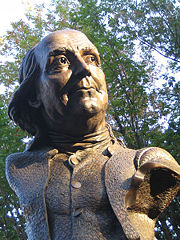
Philadelphia has more public art than any other American city. In 1872, the Fairmount Park Art Association was created, the first private association in the United States dedicated to integrating public art and urban planning.. In 1959, lobbying by the Artists Equity Association helped create the Percent for Art ordinance, the first for a U.S. city. The program, which has funded more than 200 pieces of public art, is administered by the Philadelphia Office of Arts and Culture, the city's art agency.
In particular, Philadelphia has more murals than any other U.S. city, thanks in part to the 1984 creation of the Department of Recreation's Mural Arts Program, which seeks to beautify neighborhoods and provide an outlet for graffiti artists. The program has funded more than 2,700 murals by professional, staff and volunteer artists.
Philadelphia has had a prominent role in music. In the 1970s, Philadelphia soul influenced the music of that and later eras. On July 13, 1985, Philadelphia hosted the American end of the Live Aid concert at John F. Kennedy Stadium. The city reprised this role for the Live 8 concert, bringing some 700,000 people to the Ben Franklin Parkway on July 2, 2005.
Cuisine
The city is known for its hoagies, soft pretzels, water ice, and is home to the cheesesteak. Its high-end restaurants include Morimoto, run by chef Masaharu Morimoto, who rose to prominence on the Iron Chef television show.
Sports
| Club | League | Sport | Venue | Established | Championships |
|---|---|---|---|---|---|
| Philadelphia Eagles | NFL | American Football | Lincoln Financial Field | 1933 | 1948, 1949, 1960 |
| Philadelphia Flyers | NHL | Ice Hockey | Wachovia Centre | 1967 | 1973-74, 1974-75 |
| Philadelphia Phillies | MLB | Baseball | Citizens Bank Park | 1883 | 1980 |
| Philadelphia 76ers | NBA | Basketball | Wachovia Centre | 1963 | 1966-67, 1982-83 |
| Philadelphia MLS team | MLS | Soccer | Chester Stadium | 2010 | none |
| Philadelphia Wings | NLL | Lacrosse (Indoor) | Wachovia Centre | 1987 | 1989, 1990, 1994, 1995, 1998, 2001 |
| Philadelphia Phantoms | AHL | Ice Hockey | Wachovia Spectrum | 1996 | 1997-98, 2004-05 |
| Philadelphia Soul | AFL | Arena Football | Wachovia Centre & Spectrum | 2004 | 2008 |
| Philadelphia Barrage | MLL | Lacrosse (Outdoor) | N/A | 2001 | 2004, 2006, 2007 |
| Philadelphia KiXX | MISL | Soccer (Indoor) | Wachovia Spectrum | 1995 | 2001-02, 2006-07 |
| Philadelphia WPS team | WPS | Soccer | Chester Stadium | 2010 | none |
| Philadelphia Fight | AMNRL | Rugby | Farrell Stadium ( West Chester University) | 1998 | none |
| Philadelphia Freedoms | WTT | Tennis | King of Prussia Mall | 1974 | 2001, 2006 |
Philadelphia has a long history of professional sports teams, and is one of thirteen U.S. cities to have all four major sports: the Philadelphia Eagles of the National Football League, the Philadelphia Flyers of the National Hockey League, the Philadelphia Phillies in the National League of Major League Baseball, and the Philadelphia 76ers in the National Basketball Association. The last major professional sport team to win a championship was the 76ers, which won the NBA Championship in 1983. Due to the length of this streak without winning a sports championship, in 2004 ESPN ranked Philadelphia as number two in its list of The Fifteen Most Tortured Sports Cities. The failure of Philadelphia's major professional sports teams to win championships since that date is sometimes attributed, in jest, to the so-called " Curse of Billy Penn". The Oakland Athletics and Golden State Warriors were originally from Philadelphia.
Philadelphia also is home to professional, semi-professional and elite amateur teams in other sports, including cricket. Philadelphia also hosts other major sporting events, including the Penn Relays, Stotesbury Cup, Philadelphia Marathon, and Philadelphia International Championship bicycle race, and the Dad Vail Regatta.
Philadelphia is also known for the Philadelphia Big 5, a group of five Division I basketball programs in the area. The schools in the Big 5 are Saint Joseph's University, University of Pennsylvania, La Salle University, Temple University, and Villanova University. The sixth NCAA Division I school in Philadelphia is Drexel University. At least one of the teams is competitive nearly every year and at least one team has made the NCAA tournament for the past four decades.
In February 2008, Philadelphia beat out competition from several other cities, namely St. Louis, to be awarded the 16th Major League Soccer franchise. They will enter the league in 2010 calling Chester Stadium their home (a soccer specific stadium) in Chester, PA. Philly is also the home of Extreme Championship Wrestling also known as ECW. ECW was founded by Paul Heyman now controlled by Vince McMahon with the WWE
Economy
Philadelphia's economy is relatively diversified, with meaningful portions of its total output derived from manufacturing, oil refining, food processing, health care and biotechnology, tourism and financial services. According to a study prepared by PricewaterhouseCoopers, Philadelphia and its surrounding region had the fourth highest GDP among American cities, with a total "city GDP" of $312 billion in 2005 . Only New York, Los Angeles and Chicago had higher total economic output levels.
The city is home to the Philadelphia Stock Exchange and several Fortune 500 companies, including cable television and internet provider Comcast, insurance companies CIGNA and Lincoln Financial Group, energy company Sunoco, food services company Aramark, Crown Holdings Incorporated, chemical makers Rohm and Haas Company and FMC Corporation, pharmaceutical companies Wyeth and GlaxoSmithKline, Boeing helicopters division, and automotive parts retailer Pep Boys. Early in the 20th Century, it was also home to the pioneering brass era automobile company Biddle.
The federal government has several facilities in Philadelphia as well. The city served as the capital city of the United States, before the construction of Washington, D.C. Today, the East Coast operations of the United States Mint are based near the historic district, and the Federal Reserve Bank's Philadelphia division is based there as well. Philadelphia is also home to the U.S. District Court for the Eastern District of Pennsylvania and the U.S. Court of Appeals for the Third Circuit.
Partly because of the historical presence of the Pennsylvania Railroad, and the large ridership at 30th Street Station, Amtrak also maintains a significant presence in the city. These jobs include customer service representatives and ticket processing and other behind-the-scenes personnel, in addition to the normal functions of the railroad.
The city is also a national centre of law because of the University of Pennsylvania Law School, Temple University Beasley School of Law, Villanova University School of Law, Widener University School of Law, and Earle Mack School of Law. Additionally, the headquarters of the American Law Institute is located in the city.
Philadelphia is also an important centre for medicine, a distinction that it has held since the colonial period, when Pennsylvania Hospital was the first hospital in the British North American colonies. The University of Pennsylvania, the city's largest private employer, runs an extensive medical system. There are also major hospitals affiliated with Temple University School of Medicine, Drexel University College of Medicine, and Thomas Jefferson University. Philadelphia also has three distinguished children's hospitals: Children's Hospital of Philadelphia (located adjacent to the Hospitals of the University of Pennsylvania), St. Christopher's Hospital, and the Shriners' Hospital. In the city's northwest section are Albert Einstein Hospital and in the northeast section Fox Chase Cancer Centre. Together, health care is the largest sector of employment in the city. Several medical professional associations are headquartered in Philadelphia.
In part because of Philadelphia's long-running importance as a center for medical research, the region is a major centre for the pharmaceutical industry. GlaxoSmithKline, AstraZeneca, Wyeth, Merck, GE Healthcare, Johnson and Johnson and Siemens Medical Solutions are just some of the large pharmaceutical companies with operations in the region. The city is also home to the nation's first school of pharmacy, the Philadelphia College of Pharmacy, now called the University of the Sciences in Philadelphia.
Shopping
Centre City is home to The Gallery at Market East, The Shops at Liberty Place and The Shops at the Bellevue, and a variety of standalone retail stores. Rittenhouse Row, a section of Walnut Street in Center City, has higher-end stores and boutiques. Old City and Society Hill, as well, feature upscale boutiques and retailers from local and international merchandisers. Philadelphia also has several neighbourhood shopping districts, including Manayunk and Chestnut Hill. Also noteworthy is South Street with blocks of inexpensive boutiques.
The Italian Market in South Philadelphia offers groceries, meats, cheeses and housewares from Italy and other countries. Geno's and Pat's, two famed cheesesteak outlets, are located here. The Reading Terminal Market in Center City includes dozens of restaurants, farm stalls, and shops, many run by Amish farmers from Lancaster County. There are also neighbourhood farmers' markets throughout the city. There are also several large outlet malls in the region, including Franklin Mills in Northeast Philadelphia.
Philadelphia is the birthplace of the secondary ticket marketplace. Wanamaker Ticket Office, located in Centre City, is among the nation's oldest ticket agencies.
Innovation
Philadelphia is home to many "first-in-America" institutions, including:
- Fire insurance company
- Botanical garden
- Public library
- Hospital
- Fire engine
- Fire company
- Medical school
- Pediatric hospital
- Cancer hospital
- Eye hospital
- University
- Art school & museum
- Municipal water system
- Post office
- Bank
- Stock exchange
- Mint
- Zoo
- Electronic Computer
- Philadelphia Savings Fund Society
- First Title Insurance Company in America
Demographics
| Historical populations | |||
|---|---|---|---|
| Census | Pop. | %± | |
| 1790 | 28,522 |
|
|
| 1800 | 41,220 | 44.5% | |
| 1810 | 53,722 | 30.3% | |
| 1820 | 63,802 | 18.8% | |
| 1830 | 80,462 | 26.1% | |
| 1840 | 93,665 | 16.4% | |
| 1850 | 121,376 | 29.6% | |
| 1860 | 565,529 | 365.9% | |
| 1870 | 674,022 | 19.2% | |
| 1880 | 847,170 | 25.7% | |
| 1890 | 1,046,964 | 23.6% | |
| 1900 | 1,293,697 | 23.6% | |
| 1910 | 1,549,008 | 19.7% | |
| 1920 | 1,823,779 | 17.7% | |
| 1930 | 1,950,961 | 7% | |
| 1940 | 1,931,334 | −1% | |
| 1950 | 2,071,605 | 7.3% | |
| 1960 | 2,002,512 | −3.3% | |
| 1970 | 1,948,609 | −2.7% | |
| 1980 | 1,688,210 | −13.4% | |
| 1990 | 1,585,577 | −6.1% | |
| 2000 | 1,517,550 | −4.3% | |
| Est. 2006 | 1,448,394 | −4.6% | |
As of the census of 2000, there were 1,517,550 people, 590,071 households, and 352,272 families residing in the city. The population density was 11,233.6/square mile (4,337.3/km²). There were 661,958 housing units at an average density of 4,900.1/sq mi (1,891.9/km²). As of the 2004 Census estimations, there were 1,463,281 people, 658,799 housing units, and the racial makeup of the city was 45.2% African American, 43.0% White, 5.5% Asian, 0.3% Native American, 0.1% Pacific Islander, 5.8% from other races, and 2.2% from two or more races. Hispanic or Latino of any race were 8.5% of the population. The top 5 largest ancestries include Irish (13.6%), Italian (9.2%), German (8.1%), Polish (4.3%), and English (2.9%).
Of the 590,071 households, 27.6% have children under the age of 18 living with them, 32.1% were married couples living together, 22.3% had a female householder with no husband present, and 40.3% were non-families. 33.8% of all households were made up of individuals and 11.9% had someone living alone who was 65 years of age or older. The average household size was 2.48 and the average family size was 3.22.
In the city the population was spread out with 25.3% under the age of 18, 11.1% from 18 to 24, 29.3% from 25 to 44, 20.3% from 45 to 64, and 14.1% who were 65 years of age or older. The median age was 34 years. For every 100 females there were 86.8 males. For every 100 females age 18 and over, there were 81.8 males.
The median income for a household in the city was $30,746, and the median income for a family was $37,036. Males had a median income of $34,199 versus $28,477 for females. The per capita income for the city was $16,509. About 18.4% of families and 22.9% of the population were below the poverty line, including 31.3% of those under age 18 and 16.9% of those age 65 or over.
Philadelphia has the second largest Irish, Italian, and Jamaican populations and the fourth largest African American population in the nation. Philadelphia also has the fourth largest population of Polish residents. In recent years, the Hispanic and Asian American populations have significantly increased. Hispanics have settled throughout the city, especially around El Centro de Oro, and the city now has the third largest Puerto Rican population in the continental United States. The Asian population was once concentrated in the city's thriving Chinatown, but now Korean Americans have come to Olney, and Vietnamese have forged bazaars next to the Italian Market in South Philadelphia. Concentrations of Cambodian American neighborhoods can be found in North and South Philadelphia. Indians and Arabs have come to Northeast Philadelphia along with Russian and Ukrainian immigrants. This large influx of Asians has given Philadelphia one of the largest populations of Vietnamese, Cambodians, Chinese, and Koreans in United States. The Philadelphia region also has the fourth largest population of Indian Americans. The West Indian population is concentrated in Cedar Park. Germans, Greeks, Chinese, Japanese, English, Pakistanis, Iranians, and also immigrants from the former Yugoslavia along with other ethnic groups can be found throughout the city.
Government
From a governmental perspective, Philadelphia County is a legal nullity, as all county functions were assumed by the city in 1952, which has been coterminous with the county since 1854.
The city uses the "strong-mayor" version of the mayor-council form of government, which is headed by one mayor, in whom executive authority is vested. Elected " at-large," the mayor is limited to two consecutive four-year terms under the city's home rule charter, but can run for the position again after an intervening term. The current city mayor, having taken office in January 2008, is Michael Nutter, replacing John F. Street who served two terms from 1999 to the end of 2007. Nutter, as all Philadelphia mayors have been since 1952, is a member of the Democratic Party, which tends to dominate local politics so thoroughly that the Democratic primary for mayor is often more noticeable than the general mayoral election. The legislative branch, the Philadelphia City Council, consists of ten council members representing individual districts and seven members elected at large. The current council president is Anna C. Verna.
The Philadelphia County Court of Common Pleas, also known as the Court of Common Pleas for the First Judicial District of Pennsylvania, is the trial court of general jurisdiction for Philadelphia. It is funded and operated largely by city resources and employees. The Philadelphia Municipal Court handles matters of limited jurisdiction as well as landlord-tenant disputes, appeals from traffic court, preliminary hearings for felony-level offenses, and the like. Traffic Court is a court of special jurisdiction that hears violations of traffic laws.
Pennsylvania's three appellate courts also have sittings in Philadelphia. The Supreme Court of Pennsylvania, the court of last resort in the state, regularly hears arguments in Philadelphia City Hall. Also, the Superior Court of Pennsylvania and the Commonwealth Court of Pennsylvania sit in Philadelphia several times a year. Judges for these courts are elected at large. Each court has a prothonotary's office in Philadelphia as well.

The Philadelphia Historical Commission was created in 1955 to preserve the cultural, social, political, economic and architectural history of the city. The commission maintains the Philadelphia Register of Historic Places, adding historic buildings, structures, sites, objects and districts as it sees fit.
The Philadelphia Housing Authority is the largest landlord in the entire Commonwealth of Pennsylvania. Established in 1937, it is the nation’s fourth-largest housing authority, housing approximately 84,000 people and employing 1,250. In 2006, its budget was $313 million.
Politics and elections
| Year | Republican | Democratic |
|---|---|---|
| 2004 | 19.3% 130,099 | 80.4% 542,205 |
| 2000 | 18.0% 100,959 | 80.0% 449,182 |
| 1996 | 16.0% 85,345 | 77.5% 412,988 |
| 1992 | 20.9% 133,328 | 68.2% 434,904 |
| 1988 | 32.5% 219,053 | 66.6% 449,566 |
| 1984 | 34.6% 267,178 | 64.9% 501,369 |
| 1980 | 34.0% 244,108 | 58.7% 421,253 |
| 1976 | 32.0% 239,000 | 66.3% 494,579 |
| 1972 | 43.4% 340,096 | 55.1% 431,736 |
| 1968 | 30.0% 254,153 | 61.8% 525,768 |
| 1964 | 26.2% 239,733 | 73.4% 670,645 |
| 1960 | 31.8% 291,000 | 68.0% 622,544 |
As of November 2007, there are 992,696 registered voters in Philadelphia.
- Democratic: 749,652 (75.52%)
- Republican: 150,477 (15.16%)
- Other Parties: 92,567 (9.32%)
From the American Civil War until the mid-20th century, Philadelphia was a bastion of the Republican Party, which arose from the staunch pro-Northern views of Philadelphia residents during and after the war. After the Great Depression, Democratic registrations increased, but the city was not carried by Democratic Franklin D. Roosevelt in his landslide victory of 1932 (in which Pennsylvania was one of the few states won by Republican Herbert Hoover). While other Northern industrial cities were electing Democratic mayors in the 1930s and 1940s, Philadelphia did not follow suit until 1951. That is, Philadelphia never had a "New Deal" coalition.
The city is now one of the most Democratic in the country, despite the frequent election of Republicans to statewide offices since the 1930s; in 2004, Democrat John Kerry drew 80% of the city's vote.
Philadelphia once comprised six congressional districts. However, as a result of the city's declining population, it now has only four: the 1st district, represented by Bob Brady; the 2nd, represented by Chaka Fattah; the 8th, represented by Patrick Murphy; and the 13th, represented by Allyson Schwartz. All four are Democrats; no Republican has represented a significant portion of Philadelphia since 1983. However, Pennsylvania's Republican Senator, Arlen Specter, is from Philadelphia.
Crime
Like many American cities, Philadelphia saw a gradual yet pronounced rise in crime in the years following World War II. Murders peaked in 1990 at 525, for a rate of 31.5 per 100,000. There were an average of about 400 murders a year for most of the 1990s. The murder count dropped in 2002 to 288, then surged four years later to 406. Out of the ten most populous cities in the United States in 2006, Philadelphia had the highest homicide rate at 28 per 100,000 people, though the number of murders decreased to 392 in 2007.
In 2004, there were 5,513.5 crimes per 100,000 people in Philadelphia. In 2005, Philadelphia was ranked by Morgan Quitno as the sixth-most dangerous among 32 American cities with populations over 500,000. Among its neighboring Mid-Atlantic cities in the same population group, Baltimore and Washington, D.C. were ranked second- and third-most dangerous cities in the United States, respectively, and Camden, New Jersey, a suburb across the Delaware River from Philadelphia, was ranked as the most dangerous city in the United States.
In 2006, Camden was the fifth-most dangerous city in the country, lower than its 2004 ranking, but still high for a city its size, while Philadelphia was ranked 29th.
On September 12, 2007, police commissioner Sylvester Johnson called on 10,000 African American men to patrol the streets to lessen crime. Johnson, who is black, set up "Call to Action: 10,000 Men, It's a New Day" in response to the city's disproportionate homicide rate of young African Americans. Dennis Muhammad, Nation of Islam official, and Mayor John F. Street supported the project. The program was to begin on October 21. The call was seen as a response to a widespread refusal by many African-Americans in Philadelphia to cooperate in police investigations.
Education
Education in Philadelphia is provided by many private and public institutions. The School District of Philadelphia runs the city's public schools. The Philadelphia School District is the eighth largest school district in the United States with 210,432 students in 346 public and charter schools.
Philadelphia is one of the largest college towns in the United States and has the second-largest student concentration on the East Coast with over 120,000 college and university students enrolled within the city and nearly 300,000 in the metropolitan area. There are over 80 colleges, universities, trade, and specialty schools in the Philadelphia region. Schools within the city's borders include University of Pennsylvania, Drexel University, Temple University, Saint Joseph's University, Peirce College, University of the Sciences in Philadelphia, The University of the Arts, Pennsylvania Academy of Fine Arts, Thomas Jefferson University, Moore College of Art and Design, The Art Institute of Philadelphia, Philadelphia College of Osteopathic Medicine, La Salle University, Philadelphia University, Chestnut Hill College, Holy Family University, and Community College of Philadelphia.
Infrastructure
Philadelphia is served by the Southeastern Pennsylvania Transportation Authority, or SEPTA, which operates buses, trains, rapid transit, trolleys, and trackless trolleys throughout Philadelphia, the four Pennsylvania suburban counties of Bucks, Chester, Delaware, and Montgomery, in addition to service to Mercer County, New Jersey and New Castle County, Delaware. The city's subway system, first opened in 1907, is the third oldest in America.
One of the seven SEPTA Regional Rail lines, Route R-1, offers direct service to the Philadelphia International Airport.
Philadelphia's 30th Street Station is a major railroad station on Amtrak's Northeast Corridor, which offers access to Amtrak, SEPTA, and New Jersey Transit lines.
The PATCO provides rapid transit service to Camden, Collingswood, Westmont, Haddonfield, Woodcrest (Cherry Hill), Ashland (Voorhees), and Lindenwold, New Jersey, from stations on Locust Street between 16th and 15th, 13th and 12th, and 10th and 9th Streets, and on Market Street at 8th Street.
In addition, China Airlines provides a private bus service to John F. Kennedy International Airport from the Holy Redeemer Church in the Philadelphia Chinatown to feed its flight to Taipei, Taiwan. .
Airports
Two airports serve Philadelphia: the Philadelphia International Airport (PHL), straddling the southern boundary of the city, and the Northeast Philadelphia Airport (PNE), a general aviation reliever airport in Northeast Philadelphia. Philadelphia International Airport provides scheduled domestic and international air service, while Northeast Philadelphia Airport serves general and corporate aviation. As of March 2006, Philadelphia International Airport was the 10th largest airport measured by "traffic movements" (i.e. takeoffs and landings), and was also a primary hub for US Airways.
Roads
Interstate 95 runs through the city along the Delaware River as a main north-south artery. The city is also served by the Schuylkill Expressway, a portion of Interstate 76 that runs along the Schuylkill River. It meets the Pennsylvania Turnpike at King of Prussia, Pennsylvania, providing access to Harrisburg, Pennsylvania and points west. Interstate 676, the Vine Street Expressway, was completed in 1991 after years of planning. A link between I-95 and I-76, it runs below street level through Centre City, connecting to the Ben Franklin Bridge at its eastern end.
Roosevelt Boulevard and the Roosevelt Expressway ( U.S. 1) connect Northeast Philadelphia with Centre City. The Woodhaven Road ( PA Route 63), built in 1966, serves the neighborhoods of Northeast Philadelphia, running between Interstate 95 and the Roosevelt Boulevard ( U.S. 1). The Fort Washington Expressway ( Pennsylvania Route 309) extends north from the city's northern border, serving Montgomery County and Bucks County
Interstate 476, commonly nicknamed the "Blue Route" through Delaware County, bypasses the city to the west, serving the city's western suburbs, as well as providing a link to Allentown and points north. Similarly, Interstate 276, the Pennsylvania Turnpike's Delaware River Extension, acts as a bypass and commuter route to the north of the city as well as a link to the New Jersey Turnpike to New York.
However, other planned freeways have been canceled, such as an Interstate 695 running southwest from downtown, two freeways connecting Interstate 95 to Interstate 76 that would have replaced Girard Avenue and South Street and a freeway upgrade of Roosevelt Boulevard.
The Delaware River Port Authority operates four bridges in the Philadelphia area across the Delaware River to New Jersey: the Walt Whitman Bridge (I-76), the Benjamin Franklin Bridge (I-676 and US 30), the Betsy Ross Bridge ( Route 90), and the Commodore Barry Bridge ( US 322). The Tacony-Palmyra Bridge connects PA Route 73 in the Tacony section of Northeast Philadelphia with New Jersey's Route 73 in Palmyra, Camden County, and is maintained by the Burlington County Bridge Commission.
Philadelphia is also a major hub for Greyhound Lines, which operates 24-hour service to points east of the Mississippi River. Most of Greyhound's services in Philadelphia operate to/from the Philadelphia Greyhound Terminal, located at 1001 Filbert Street in Centre City Philadelphia. In 2006, the Philadelphia Greyhound Terminal was the second busiest Greyhound terminal in the United States, after the Port Authority Bus Terminal in New York. Besides Greyhound, six other bus operators provide service to the Centre City Greyhound terminal. These are Bieber Tourways, Capitol Trailways, Martz Trailways, Peter Pan Bus Lines, Susquehanna Trailways, and the bus division for New Jersey Transit.
Rail
Since the early days of rail transport in the United States, Philadelphia has served as hub for several major rail companies, especially the Pennsylvania Railroad and the Reading Railroad. The Pennsylvania Railroad first operated Broad Street Station, then 30th Street Station and Suburban Station, and the Reading Railroad operated out of Reading Terminal, now part of the Pennsylvania Convention Centre. The two companies also operated competing commuter rail systems in the area, known collectively as the Regional Rail system. The two systems today, for the most part still intact but now connected, operate as a single system under the control of the SEPTA, the regional transit authority. Additionally, Philadelphia is linked to Southern New Jersey via the Port Authority Transit Company subway system.
Philadelphia is one of the few North American cities to maintain streetcar lines. In addition to "subway-surface" trolleys - which are so called because during the years when the city was served by over 2000 trolleys and more than 65 lines, these "surface" cars also ran in the streetcar subway - the city recently reintroduced trolley service to the Girard Avenue Line, Route 15, considered by some a "heritage" line. Though the use of rebuilt 1947 PCC streetcars was primarily for budgetary reasons, rather than as a historic tribute.
Today Philadelphia is a hub of the semi-nationalized Amtrak system, with 30th Street Station being a primary stop on the Washington-Boston Northeast Corridor and the Keystone Corridor to Harrisburg and Pittsburgh, Pennsylvania. 30th Street also serves as a major station for services via the Pennsylvania Railroad's former Pennsylvania Main Line to Chicago. 30th Street is Amtrak's third-busiest station in numbers of passengers as of fiscal year 2003. It is also a terminus of New Jersey Transit's Atlantic City Line.
Telecommunications
Southeastern Pennsylvania was once served only by the 215 area code, beginning in 1947 when the North American Numbering Plan of the " Bell System" went into effect. The area covered by the code was severely truncated when area code 610 was split from 215. Today only the city and its northern suburbs are covered by 215. An overlay area code, 267, was added to the 215 service area in 1997. A plan to introduce area code 445 as an additional overlay in 2001 was delayed and later rescinded.
Philadelphia is now also served by Wireless Philadelphia, a citywide initiative to provide Wi-Fi service. The Proof of Concept area was approved on May 23, 2007, and service is now available in many areas of the city.
Sister cities
Philadelphia has ten sister cities, as designated by the International Visitors Council of Philadelphia (IVC):
Philadelphia has dedicated landmarks to its sister cities. Dedicated in June 1976, the Sister Cities Plaza, a one-half-acre site located at 18th and Benjamin Franklin Parkway, honours Philadelphia's relationships with Tel Aviv and Florence which were its first Sister Cities. Another landmark, the Torun Triangle, honoring the Sister City relationship with Toruń, Poland, was constructed in 1976, west of the United Way building at 18th Street and the Benjamin Franklin Parkway. The Triangle contains the Copernicus monument. The Chinatown Gate, erected in 1984 and crafted by artisans of Tianjin, China, stands astride the intersection of 10th and Arch Streets as an elaborate and colorful symbol of the Sister City relationship.
- Philadelphia is at coordinates Coordinates:
